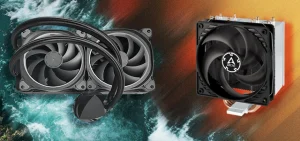
As high computing power and high-density server racks become more common, traditional air cooling methods have struggled to keep up. Enter liquid cooling technology. In this blog, we’ll compare the two systems to demonstrate how far data center cooling technology has come.
As for Air Cooling, an air-cooled data center draws in outside air through an intake on the air handler. The accumulated air is cooled by computer room air conditioning (CRAC) units and then dispersed through raised floors into “cold aisles”. This cold air is then circulated through the servers to cool them and then out the back. The back area is called the “hot aisle” and it is discharged through a tube to the air handlers.
Single-phase Immersion Cooling is based on the fact that liquids conduct heat better than air. The server is submerged in a cooling bath of dielectric liquid. The coolant conducts heat to the server components through direct contact. The heated coolant is then circulated between the rack and the cooling distribution unit (CDU) and connected to a warm water cycle after leaving the top of the rack. The final heat removal stage in this cycle is the cooling tower on the other side. The heat exchanger then returns the cooled liquid to the final rack.
Complexity and upfront costs
Air Cooling
Compared to immersion, air cooling technology is the most complex option. However, it is the technology that has served the data center industry the longest, for about 50 years. Air cooling technology may seem simple. But in reality, implementing such systems requires a long list of equipment, practices, and strategies. In addition, this equipment requires large generators, and UPS to run. And all of these complications equate to significant capital expenditures.
Single-Phase Cooling
Unlike air cooling, single-phase cooling technology does not require raised floors and aisle closures. In addition to maximizing the space capacity of the data center, it has only three moving parts – coolant pumps, water pumps, and cooling towers. This can help reduce data center capital expenditures by at least 50%. In addition, CFD analysis of airflow is not required in the case of liquid immersion. Racks can now be placed closely together without the need for raised floors.
Efficiency and Operating Costs
Air Cooling
The reality is that the heat transfer efficiency of air is 1200 times lower than that of liquids. Not only does this make data center cooling inefficient, but it only adds to the operating costs of the facility. Fans account for 20% of the electricity used by servers. Energy-consuming cooling components are also needed to improve the efficacy of air. As a result, the size of the power infrastructure suffers.
Single-phase Cooling
Single-phase immersion cooling reduces energy use by 90%, and up to 50% of the total energy use in a data center compared to air cooling. This is due to the reduced infrastructure requirements with only three moving parts.
By the way, the cost of air conditioning improvement is not in electricity, but also in labor. Annual maintenance contracts for equipment can be quite expensive. With single-phase immersion cooling, none of this is necessary.
Cooling capacity and high-density performance
Air Cooling
Some air-cooled data centers do have the ability to cool racks with cooling capacities up to 30-35kW. However, at 15kW/rack, air-cooled data centers become inefficient. The growth of the industry has exacerbated this problem. GPUs, which consume a lot of power, are making their way into HPC applications such as IoT and artificial intelligence. Intel’s® Skylake’s new products, for example, use a staggering 250 kW of power. Put two of these on a 1U server. Then, add 200 kW of additional electronics and multiply that by 40 servers. Now you have a CPU-based system with a power output of 28 kW. When you add co-processors and gas pedals, air cooling is no longer an option. Data center operators may be inclined to build racks of mixed density to meet demand. When it comes to air cooling, hot spots are inevitable, which can lead to hardware failure. At the next hardware refresh, air-cooled data center operators will face serious liquidation as a result of this technology.
Single-phase Cooling
Single-phase immersion cooling systems are designed to break through the thermal barrier. And hopefully, this will take data center computing to the next level – and beyond.
Reliability and location flexibility
Air Cooling
Any cooling system that draws air in from the outside is a surefire way to cause hardware failure. Why? Because it exposes IT assets to dangerous airborne contaminants. This refers to corrosion and oxidation. Depending on the air quality and humidity level of the unconditioned air, this danger rises. Data centers built in places with excessive humidity, air pollution or wind-blown particles are vulnerable to corrosion. Incidentally, these issues are growing as the demand for remote edge deployments grows.
Single-phase Cooling
Single-phase immersion cooling scores the greatest possible points in this area due to three key factors: First, it is, without question, the most basic and practical cooling method available. In addition, there are fewer things that can go wrong: 1.) no chillers, 2.) air handlers, 3.) humidity controllers, etc.; no server fans to cause vibrations and thus lower MTBF. second, important IT assets are isolated from the outside air by immersion, eliminating any environmental problems. Finally, the data center is free of hot spots.
What’s more, if you are interested in single-phase Cooling cooling, take a look at our boxtechy immersion cooling products and choose the one that’s right for you!


